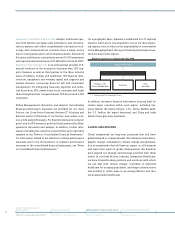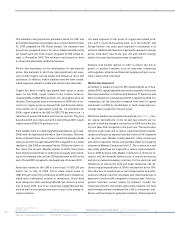Siemens 2009 Annual Report Download - page 144
Download and view the complete annual report
Please find page 144 of the 2009 Siemens annual report below. You can navigate through the pages in the report by either clicking on the pages listed below, or by using the keyword search tool below to find specific information within the annual report.
6
Reports Supervisory Board /
Managing Board Corporate Governance Management’s discussion and analysis Consolidated Financial Statements
44 Business and operating environment 63 Fiscal 2009 – Financial summary 66 Results of operations 84 Financial position
tion of new orders thus occurs when the underlying revenue is
recognized.
Order backlog represents the future revenues of our Company
resulting from already recognized new orders. Order backlog is
calculated by adding the new orders of the current fiscal year
to the balance of the order backlog from the prior fiscal year
and subtracting the revenue recognized in the current fiscal
year. If an order from the current fiscal year is cancelled or its
amount is modified, we adjust our new order totals for the cur-
rent quarter accordingly, but do not retroactively adjust previ-
ously published new order totals. However, if an order from a
previous fiscal year is cancelled, new orders of the current
quarter and accordingly the current fiscal year are generally
not adjusted, instead, if the adjustment exceeds a certain
threshold, the existing order backlog is revised. Aside from
cancellations, the order backlog is also subject to changes in
the consolidation group and to currency translation effects.
There is no standard system for compiling and calculating new
orders and order backlog information that applies across com-
panies. Accordingly, our new orders and order backlog may not
be comparable with new orders and order backlog reported by
other companies. We subject our new orders and our order
backlog to internal documentation and review requirements.
We may change our policies for recognizing new orders and
order backlog in the future without previous notice.
NON-FINANCIAL PERFORMANCE MEASURES
The Fit42010 program specifies the priorities and performance
targets we believe will enable us to achieve our overall strat-
egy, which is to sustain profitable growth by addressing the
opportunities inherent in global megatrends. The program
thus contains both financial and non-financial performance
measures chosen to help us to strengthen our leadership posi-
tions or close the gap to our leading competitors. For a descrip-
tion of the financial performance measures included in
Fit42010, see “– Financial performance measures” earlier in
this report.
Following comprehensive analyses of competitive bench-
marks, we calculate our capital structure measure as the ratio
of “adjusted industrial net debt” to “EBITDA (adjusted)”. For
further information on this calculation, see “Financial position
– Capital structure.” We aim to achieve a ratio in the range of
0.8 – 1.0.
Definition of other financial performance measures
We also use other financial performance measures in addition
to the measures described above, such as new orders and or-
der backlog for the assessment of our future revenue potential.
We define and calculate new orders and order backlog as fol-
lows:
Under our policy for the recognition of new orders, we gener-
ally recognize a new order when we enter into a contract that
we consider “legally effective and binding” based on a number
of different criteria. In general, if a contract is considered le-
gally effective and binding, we recognize the total contract
value. The contract value is the agreed price or fee for that por-
tion of the contract for which the delivery of goods and/or the
provision of services is irrevocably agreed. Future revenues
from service, maintenance and outsourcing contracts are rec-
ognized as new orders in the amount of the total contract
value only if there is adequate assurance that the contract will
remain in effect for its entire duration (e.g., due to high exit
barriers for the customer). New orders are generally recog-
nized immediately when the relevant contract becomes legally
effective and binding. The only exception is orders with short
overall contract terms. In this case, a separate reporting of new
orders would provide no significant additional information
regarding our performance. For orders of this type the recogni-
Capital structure (continuing operations)
FY 2009 0.31
FY 2008 0.39
Target corridor: 0.8 – 1.0
Adjusted industrial net debt
EBITDA (adjusted)
B25G012_E
























